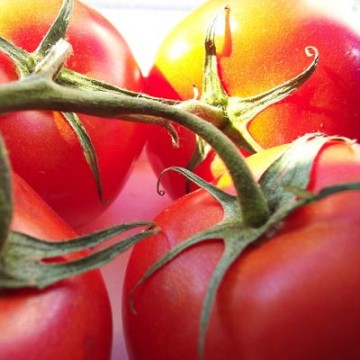The Last Sip of Summer: Tomato Wine
Thursday, September 25, 2014

Photo Credit: kait jarbeau is in love with you via Compfight cc
Mwuah-ha-ha. Others might be a bit more skeptical to try.
Confession: I have never actually tasted tomato wine.
Is it red and splotchy? I wonder.
Does it taste sour, fruity or just plain weird? I am desperate to find out.
It is easy to imagine housewives and winos of the Prohibition era turning their extra summer bounty of tomatoes into delicious wine.
In fact, home vinting was technically still legal under Prohibition. Some California grape growers produced grape concentrate with the warning "After dissolving the brick in a gallon of water, do not place the liquid in a jug away in the cupboard for twenty days, because then it would turn into wine." (Paul Aaron and David Musto, 1981).
This Civil War-era tomato wine recipe uses a simple wild fermentation process, using only yeasts found in the air:
Tomato Wine - take a quantity of ripe tomatoes, press and strain them through a tolerably fine cloth that the liquor may be as clear as possible. Then add a half a pint of good brown sugar to each quart of juice. Put in bottles or jugs, and as soon as it ferments it will be ready for use. Thus a delightful light wine may be made in a few days at the cost of 20 cents per gallon if tomatoes are grown at home and not bought. A gallon will afford 16 pints so that one may enjoy a good glass (1/2 a pint) of wine at a small fraction over a cent a glass. (Union and Recorder, Jun. 27, 1876)
So our great-great-grandpas were swilling this stuff. When exactly did we lose a taste for it?
The world’s only major commercial producer of tomato wine is Omerto Vineyards in Ontario, Canada. A secret family recipe passed down from vinter Pascal Miche’s grandfather, who crafted his tomato wine from yellow and black cherry tomatoes. Miche experimented with more than a dozen tomato varieties before he found varieties that grow well in the colder climate of Eastern Canada.
The wine is comparable to a white wine, with a lovely golden color.
As of 2012, Omerto sales were at 34,000 bottles a year and growing. Of course, across the pond tomato wine is not considered real wine, which of course can only be made from wine making grapes.
More for us, I say.
DIY Challenge
Technically, you can make wine out of everything. Chop fruit up, add sugar and yeast and you get alcohol.
Of course, there are a few more steps from fermenting to decanting, but luckily all you need is sugar, tomatoes, a pack of yeast and a couple of buckets. These are cheap, so there. More than perfect execution, the power of great wine lies within the vinter’s imagination.
Hey, trendy PDX, I dare you to make this. Wait a year. Let me know it goes.
Most recipes call for equal parts sugar and tomatoes. One recipe I found called for 12 pounds of tomatoes and 12 pounds of sugar. Depending on how many gallons you want to make, that can seem like a LOT of sugar. But considering that grapes are one of the fruits with the highest sugar content, it probably all equals out in the end.
Good thing sugar is so cheap.
One can substitute honey for white sugar, but this upgrade would significantly raise the production cost of each bottle and will produce a slightly different-flavored wine.
So are you ready to make your own yet? The key to a flavorful tomato wine is picking tomatoes that are at their peak of ripeness. To know when a tomato is ripe, look for the little bent “knuckle” on the stem about an inch up the stem of each fruit. The tomato should break off easily at the knuckle. Store harvested tomatoes in a cool dark place, as sun and cold dampens their flavor.
This tomato wine recipe makes one gallon of wine, so weigh your tomatoes and multiply all the ingredients out, except for the yeast packet.
- 4 lbs fresh, ripe red tomatoes
- 2 lbs granulated sugar
- 3-1/2 qts boiling water
- 2 tsp acid blend
- 1/2 tsp pectic enzyme
- 1/8 tsp grape tannin
- 1 tsp yeast nutrient
- 1 crushed Campden tablet
- 1 pkg Champagne or Montrachet yeast
Boil water and dissolve sugar. Meanwhile, wash and cut fruit into chunks, discarding any insect-scarred parts. Pour fruit and any juice from cutting into nylon straining bag in primary. Tie bag and squash the fruit. Pour the boiling water with dissolved sugar over fruit. Cover and allow to cool one hour, then add acid blend, tannin, yeast nutrient, and crushed Campden tablet. Stir, re-cover and after 12 hours add pectic enzyme.
Wait another 12 hours and add yeast. Stir twice a day for seven days. Remove nylon bag and allow to drip drain, adding drained juice to primary; do not squeeze bag. Siphon liquid off sediments into secondary, top up, and fit airlock. Rack every 60 days until wine clears, then wait two weeks and rack again. Add stabilizer, wait 10 days, sweeten to taste with sugar water, then bottle.
Wine will mature in one year and should be served chilled.
(Adapted from Terry Garey's "The Joy of Home Winemaking")
An urban farmer and master gardener, Amélie Rousseau writes for fellow explorers and eaters of the plant kingdom. It's a jungle out there.
Banner Photo Credit: St0rmz via Compfight cc
Related Articles
- Say Farewell to Summer With a Blackberry Binge
- Pretty Enough to Eat: Portland Blooms With Edible Flowers
- Five Cold Summer Soups to Warm Your Heart
- S’mores Time! Six New Takes on the Classic Campfire Treat




Follow us on Pinterest Google + Facebook Twitter See It Read It